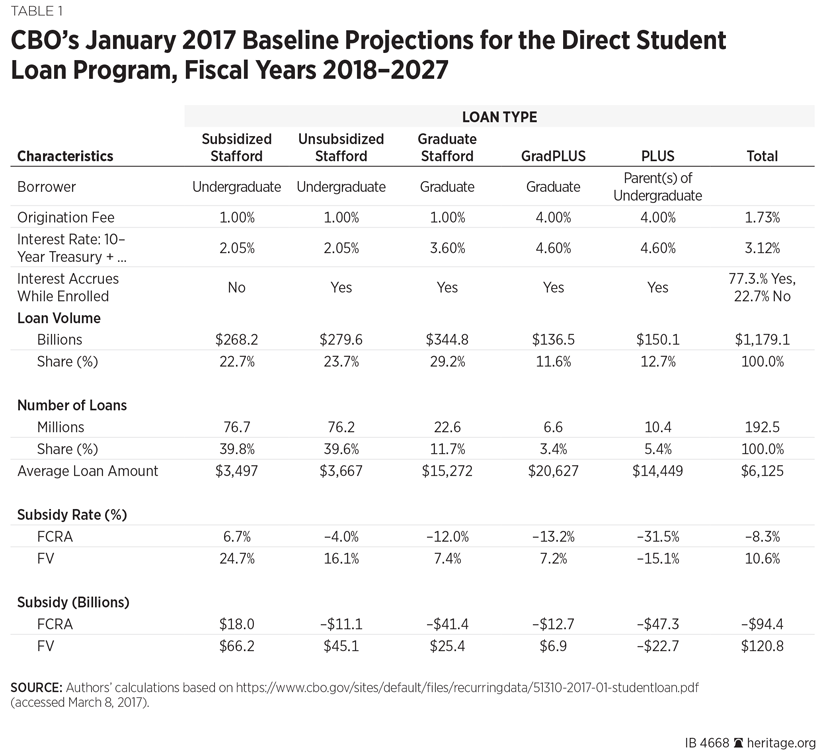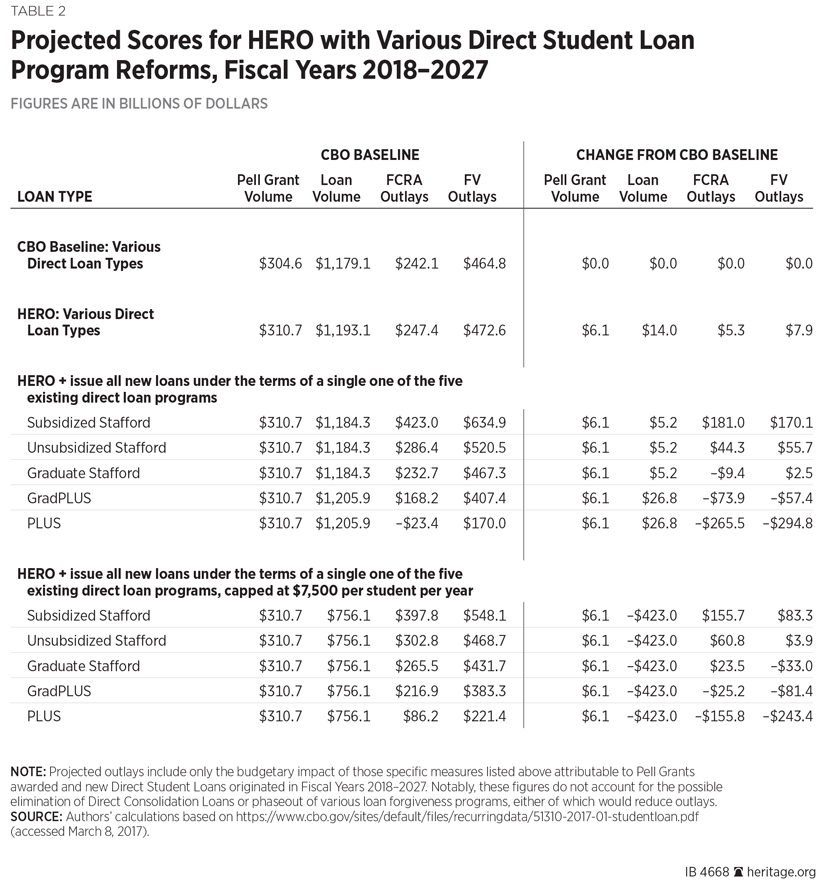As Congress considers reauthorization of the Higher Education Act (HEA), it should pursue two overarching goals: decoupling federal financing from accreditation, a policy included in the Higher Education Reform and Opportunity (HERO) Act, and structurally reforming the federal loan programs to encourage private lending.
Specifically, decoupling federal financing from accreditation and issuing all new loans under the current terms of Graduate Stafford Loans would generate savings relative to the Congressional Budget Office (CBO) baseline of $9.4 billion under the Federal Credit Reform Act (FCRA), or a cost of $2.5 billion under fair value (FV) accounting, and bring savings closer to revenue neutrality than any other loan type. Capping federal lending at $7,500 per student per year and including an aggregate lifetime borrowing cap would save American taxpayers $33 billion over the next decade, reduce total federal student lending by 35.5 percent, and enhance the private lending market’s ability to serve students.
The Higher Education Reform and Opportunity Act
In 2014, Senator Mike Lee (R–UT) and Representative Ron DeSantis (R–FL) introduced the Higher Education Reform and Opportunity Act. Unlike the policy contained in the HEA, which conditions access to federal student aid on accreditation through federally approved accrediting entities, the HERO Act would allow all states and the District of Columbia to opt out of the current federally sanctioned accreditation structure and allow any entities approved by a state to accredit colleges and courses of study and credential individual classes. As Senator Lee explained in a speech at The Heritage Foundation:
Imagine having access to credit and student aid for a program in computer science accredited by Apple or in music accredited by the New York Philharmonic; college-level history classes on-site at Mount Vernon or Gettysburg; medical-technician training developed by the Mayo Clinic…. Students could mix and match courses, programs, tests, online credits à la carte, pursuing their degree or certification at their own pace while bringing down costs to themselves, their families, and the taxpayers.[REF]
This student-centered approach to accreditation reform could foster much-needed innovation in higher education and link student learning to skills needed in the marketplace. With outstanding student loan debt now exceeding $1.3 trillion and another $1.2 trillion in new federal student loans expected to be originated in the next 10 years,[REF] students and taxpayers have much to gain from accreditation reforms that increase learning options and lower costs.
Coupling Accreditation Reform with Changes to Federal Student Aid
In recent years, Washington has increased its involvement in higher education to the point that 90 percent of all student loans are originated by the federal government.[REF] This is problematic for several reasons. First, federal lending offers students below-market interest rates together with generous repayment options such as income-based repayment as low as 10 percent of discretionary income with loan forgiveness after 10–25 years. In an effort to ease the burden of high college tuition, policymakers have made many students virtually immune to tuition price increases by encouraging them to take on larger amounts of debt and insulating them from repayment through generous caps and forgiveness policies.
In fact, substantial evidence suggests that the federal government’s unrestrained lending practices incentivize colleges and universities to raise their tuition prices. A 2015 report from the Federal Reserve Bank of New York found that every additional dollar an institution receives in federally subsidized student loans leads to a tuition increase of an astounding 63 cents.[REF] Similarly, economists at the Mercatus Center at George Mason University found that the rise in college tuition is closely linked to the rise in federal student aid programs, even after accounting for declines in state appropriations, which are often blamed for increases in tuition.[REF]
In light of the growing body of research suggesting that existing student loan policies do little to make college affordable, policymakers should consider widespread restructuring of the federal government’s lending practices. Consolidating the current loan options into a single loan program that includes annual and lifetime borrowing caps would encourage private lending, reduce student loan burdens, and put long-overdue pressure on colleges and universities to rein in costs.
Projected Scores for HERO with Various Direct Student Loan Program Reforms
The budgetary impact of decoupling federal financing from accreditation would likely be small, primarily facilitating short-term, lower-cost educational opportunities. If the HERO Act, for example, were to lead to a doubling of participation in academic programs of less than two years (the smallest unit of analysis to model that is close to students using Title IV funds for individual classes and courses of study), it would increase participation in undergraduate Title IV programs by only 2 percent,[REF] Pell Grant outlays would increase by $6.1 billion, from $304.6 billion to $310.7 billion, and Direct Student Loan Program outlays would decline by $0.8 billion, from -$62.5 billion to -$63.3 billion, for a net increase of $5.3 billion in outlays relative to the CBO baseline from fiscal year (FY) 2018 through FY 2027.[REF]
The Direct Student Loan Program generates a profit of $62.5 billion, or 8.3 percent of loan volume, in the CBO baseline, which is based on the Federal Credit Reform Act of 1990 (FCRA) and uses U.S. Treasury rates to discount future cash flows. (See Table 1.) Under the FV estimation method, which discounts future cash flows at a higher rate to better account for risk in the timing of those flows, the program loses $160.2 billion, or 10.6 percent of loan volume. However, the Department of Education currently issues five different types of direct student loans with varying requirements and terms.

Under FCRA, only Subsidized Stafford Loans are considered unprofitable, while under FV, only PLUS Loans to parents are considered profitable. Issuing all future direct loans under a single set of terms would simplify the program and eliminate some perverse incentives in current law.[REF] As noted, issuing all new loans under the current terms of Graduate Stafford Loans would generate savings relative to the CBO baseline of $9.4 billion under FCRA, or a cost of $2.5 billion under FV accounting, closer to revenue neutrality than any other loan type. (See Table 2.)

Loans to graduate students—who should face little difficulty in obtaining private financing even for costly courses of study if those courses are worthwhile—represent only 15.2 percent of the number of loans but 38.7 percent of loan value. A cap of $7,500 per student per year would reduce graduate school lending to 22.4 percent of loan value and total lending by 35.5 percent relative to the CBO baseline while costing $23.5 billion under FCRA or saving $33.0 billion under FV accounting over 10 years.
These cost estimates do not account for the tremendous potential savings associated with the elimination of loan forgiveness under income-driven repayment plans. In November 2016, the Government Accountability Office (GAO) reported that loans originated in FY 2017 alone, expected to be repaid under income-driven repayment plans,[REF] will receive a subsidy of $14.6 billion under FCRA.[REF] In December 2016, the CBO scored a cap on Public Service Loan Forgiveness of $57,000 per person and an extension of the repayment period from 20 to 25 years for borrowers who take out loans for graduate school as saving $19.3 billion under FCRA or $13.9 billion under FV accounting over 10 years.[REF] Neither the CBO nor the GAO has estimated the savings associated with eliminating loan forgiveness altogether, and more detailed data should be released to enable researchers to apply standard analytic techniques to do so.[REF]
Conclusion
Heavy federal government intervention in the higher education financing system increases bureaucratic red tape and puts harmful incentives into the marketplace, doing little to improve affordability. The policies embodied in the HERO Act would spur state-level innovation in higher education by allowing federal financing with state-level accreditation at a modest cost of an estimated $7.9 billion over 10 years under fair value accounting. Eliminating loan forgiveness policies and consolidating federal lending into a single loan program could alleviate much of the student loan burden that is placed on taxpayers and would ensure that the CBO also scores the bill as a net budgetary savings even under FCRA.
Any changes in the Higher Education Act of 1965 should incorporate these much-needed reforms of the higher education sector.
—Jamie Bryan Hall is a Senior Policy Analyst in the Center for Data Analysis, of the Institute for Economic Freedom, at The Heritage Foundation. Mary Clare Reim is a Policy Analyst in the Center for Education Policy, of the Institute for Family, Community, and Opportunity, at The Heritage Foundation.


